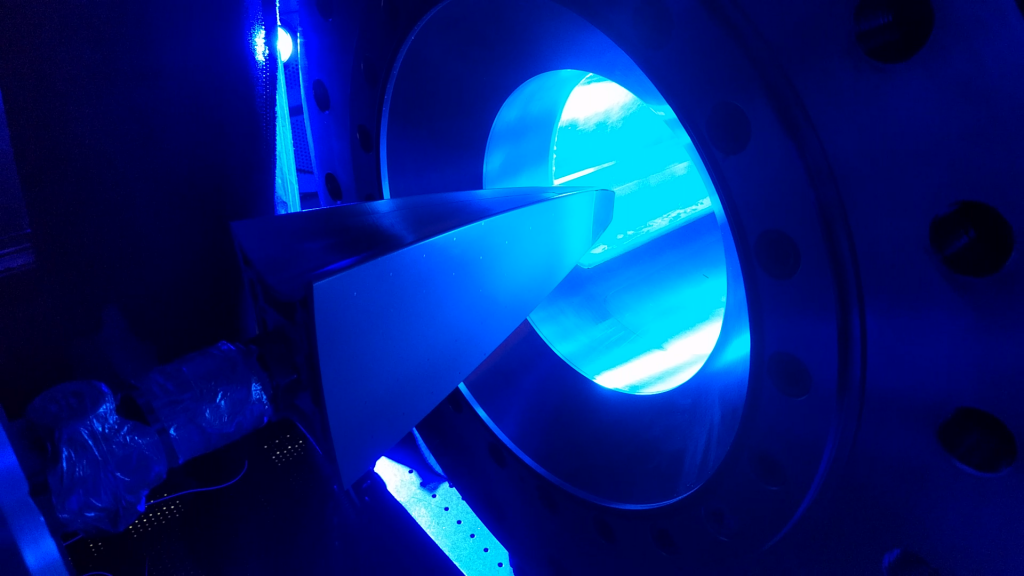ARNOLD AIR FORCE BASE, Tenn. (AFNS) — When those conducting Air Force-sponsored basic science research in hypersonic aerodynamics needed some advice, they relied upon the expertise of engineers and technicians at Arnold Engineering and Development Complex Hypervelocity Wind Tunnel 9 in White Oak, Maryland.
Earlier this year, personnel from Tunnel 9 provided instrumentation installation training to members of the research team from the Johns Hopkins University Applied Physics Laboratory, or JHU-APL, in Laurel, Maryland, working on the Boundary Layer Transition, or BOLT, flight experiment.
The aim of the BOLT experiment is to predict the state of the boundary layer, or the thin layer of air near the surface, of a new canonical geometry that has concave surfaces and swept leading edges. According to APL, the ability to predict when the air transitions from moving in a smooth line across the vehicle surface to becoming turbulent and swirling around it will help determine the heating to bodies moving at hypersonic speeds. Determining where boundary layer transition occurs also helps to plan better for aerodynamic drag.
The Air Force Research Laboratory and Air Force Office of Scientific Research awarded a research grant to JHU-APL to conduct the BOLT experiments in order to progress the understanding of boundary layer transition physics. The BOLT flight experiment is a multi-organizational effort that includes research groups from academic, commercial and government institutions across the nation and German Aerospace Center in Germany. It has also trained graduate students from across the country.
“BOLT is changing the paradigm on how we involve students and academia in flight experiments, working side-by-side with university-affiliated research centers, (government) labs and industry,” said Dr. Ivett Leyva, from Air Force Research Laboratory and Air Force Office of Scientific Research.
To conduct the experiment on a more complex geometry, the BOLT shape was developed. The shape features a cylindrical nose tip followed by four symmetric highly-swept leading edges and two symmetric upper and lower concave surfaces. It also features side “gutter” surfaces which isolate flow between the independent surfaces and leading edges.
While the JHU-APL instrumentation selection was driven by the understanding of physics gained with ground testing and analysis, the goal of the BOLT experiment is to gather high-quality measurements at actual hypersonic flight conditions with a sounding rocket system.
JHU-APL staff member Dr. Brad Wheaton, who is the principal investigator for BOLT, approached Tunnel 9, located less than 15 miles from JHU-APL, to provide training for the installation of Medtherm coaxial thermocouple sensors on the BOLT experimental payload. This instrumentation is used to measure temperatures during the flight experiment.
“Tunnel 9’s staff and technicians have tremendous experience with these Medtherm sensors in particular, and we wanted to make sure we learned from Tunnel 9 about how the facility installs these sensors successfully on their wind tunnel models,” Wheaton said. “We’ve utilized T9 staff as a resource to ensure that we are following best practices with these unique instruments.”
An in-person training session was arranged. In advance of this meeting, Tunnel 9 staff sent several training videos to JHU-APL.
Onsite training, which focused on procedures and direction for installing the coaxial thermocouples in the BOLT hardware, occurred at Tunnel 9 in May.
“We brought a replica piece of our flight hardware so that the T9 staff could understand some of the unique challenges we face to installing these sensors on the BOLT geometry, particularly in the highly-swept leading edge regions,” Wheaton said. “We figured that T9, having instrumented so many different geometries, has probably seen it all.”
Wheaton and two other JHU-APL staff members involved in the sensor installation attended the training session led by Tunnel 9 Engineering technician Dave Eisentraut.
“Dave Eisentraut has numerous years of experience in working with and installing instrumentation in wind tunnel models, including coaxial thermocouples,” said Tunnel 9 Project engineer George Moraru, who was involved in coordinating the training and providing some technical assistance. “He advised JHU-APL employees on our installation methodologies and provided guidance based on his extensive knowledge of instrumentation installation.”
In addition, Tunnel 9 Technical Director John Lafferty and other Tunnel 9 staff have attended BOLT design reviews and provided feedback on the design of the flight experiment hardware.
“As we nationally prepare to fly hypersonically more, efforts like this highlight the special skills the Air Force Test Center has across our enterprise and that we are capable and expected to contribute much more than air-on hours,” said Tunnel 9 Site Director Dan Marren. “This is a great example of leveraging our skills we utilize every day to reduce risk to the nation’s program in hypersonics.”
Moraru said both JHU-APL and AFRL and AFOSR expressed appreciation to Tunnel 9 staffers for their help.
“After the BOLT flight, we look forward to hearing how the training assisted in acquiring critical flight data,” he said.

The Boundary Layer Transition, or BOLT, subscale model is tested in the Purdue University Mach-6 Quiet Tunnel. The aim of the basic science BOLT experiment, which is being sponsored by the Air Force Research Laboratory/Air Force Office of Scientific Research and conducted by the Johns Hopkins University Applied Physics Laboratory (JHU-APL), along with the University of Minnesota, Purdue University, Texas A&M University, AFRL Aerospace Systems Directorate, NASA Langley, CUBRC, VirtusAero and DLR in Germany, is to predict the state of the boundary layer, or the thin layer of air near the surface, on a new canonical geometry. Personnel at AEDC Hypervelocity Wind Tunnel 9 in White Oak, Maryland, recently provided sensor installation training to JHU-APL staff members. (Courtesy photo by Air Force Office of Scientific Research/Johns Hopkins University Applied Physics Laboratory)

